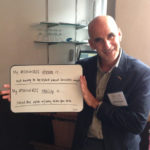The Social ROI Debate
 Like the proverbial dog with a bone, I’m not letting go of my obsessive search for an answer to the question, “is there a formula for measuring the ROI of social media?” This journey led to a dinner last week with a dozen marketing professionals where we debated the topic of Social ROI at length. For the most the part, the group could be divided into two camps, those who believed that measurement was just a matter of isolating variables AND those who believed there were too many intervening factors to show direct cause and effect.
Like the proverbial dog with a bone, I’m not letting go of my obsessive search for an answer to the question, “is there a formula for measuring the ROI of social media?” This journey led to a dinner last week with a dozen marketing professionals where we debated the topic of Social ROI at length. For the most the part, the group could be divided into two camps, those who believed that measurement was just a matter of isolating variables AND those who believed there were too many intervening factors to show direct cause and effect.
It was a spirited discussion to say the least. Among those leading the charge for measurability was Ted Rubin, the author of Return on Relationship, a book with the subtitle “Relationships are the new currency: honor them, invest in them, and start measuring your ROR.” Clearly Ted has a lot to say on this subject and he was kind enough to agree to the interview below during which he identifies what I’d call directional indicators of ROI like Lifetime Value of a Customer and the relative value of connected versus non-connected customers. More importantly in my mind at least, Ted also offers some excellent advice on how build these relationships, without which there is no hope of ROI or RonR.
Drew Neisser: How is RonR different than a company's "goodwill" in accounting terms?
Ted Rubin: Good will cannot be measured, but factors of RonR can. Lifetime Value of a Customer, Average Order Value, and Frequency of Purchase.
Drew Neisser: How would a brand use ROI metrics to measure RonR? Are there any data trends that would indicate the brand relationships are taking a positive trajectory?
Ted Rubin:At this time, looking at customer lifetime value is a really attractive way to measure both ROI and ROR when it comes to Social Media. Syncapse's recent study shows a significant and positive difference in customer value, when comparing non-followers vs followers in Social Media. Not only do they purchase more, but their advocacy creates new Word of Mouth value for the brand. An ongoing measurement comparing average non-connected customers to connected customers will help any brand gain a great understanding into just how valuable those online relationships are.
Drew Neisser: Would you ever advocate for artificial intervention if the response to a campaign is lukewarm, even after a company takes the steps you recommend to build meaningful relationships (listening, making it "the channel of me," etc.). For example, buying Twitter followers or internally commissioning positive reviews/comments
Ted Rubin: Never, ever buy Twitter followers. They are worthless. Now... paying someone who knows how to properly aggressively grow your Twitter following, that is incredibly worthwhile if they know how to do it properly and add value at the same time. But that cannot happen overnight to jumpstart a campaign.
Drew Neisser: What were some of the brand relationship issues you encountered at the companies you've managed, and how did you employ your theory of RonR to ameliorate them?
Ted Rubin: For the most part it has been about the feeling that companies are not listen... so listen, and take actions that make it incredibly obvious you are doing so... then make sure that is easily shared. In addition the very best thing you can do to add RonR is bringing the marketing silo in line with the customer svc silo. Since it is incredibly rare that the CMO has jurisdiction over cust svc, important to reach out to person running it and work closely together. Amazing the RonR that is achieved by simply replacing product, and aligning the two. Also when a CMO actually interacts with with customers via social has an incredible impact in customer relations and with social that word is spread incredibly fast. Be real, authentic, and engaging and the results with affect your bottom line. Actively look for and engage critics. I LOVE critics... first if there is one there are hundreds more. Engage them publicly and you can resolve issues for many at once and show your willingness to do so. Most critics are incredibly easy to turn into Dynamic Advocates... simply BE NICE and replace their product.
Drew Neisser: At what point do you think consumers "break up" with a brand, and, if possible, how do you build up a relationship with consumers who are on the brink of abandoning it?
Ted Rubin: Consumers break up when they are not being heard... simple. So... LISTEN, HEAR, and let then know you do. I know this seems like common sense, but unfortunately, or fortunately for those brands who DO get it, common sense (and using good Judgement) is not very common. Also the pervading fear of such interactions make them a goldmine for those who recognize the value.
Drew Neisser: If a small company has managed to build a meaningful, loyal customer base but doesn't have the manpower to adequately handle these relationships at the same level over time, what are some effective steps the brand can take to prevent defection?
Ted Rubin: Simple... empower your employees to do the work. Allow them to interact and engage... encourage it. Also encourage and empower them all to build their own personal brands and social media influence/connection/following. Especially in a small company, your employees should be your strongest and most valuable advocates.